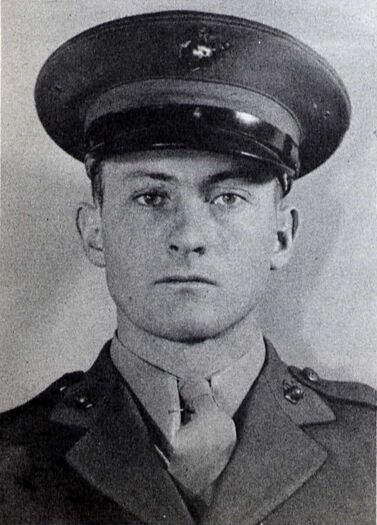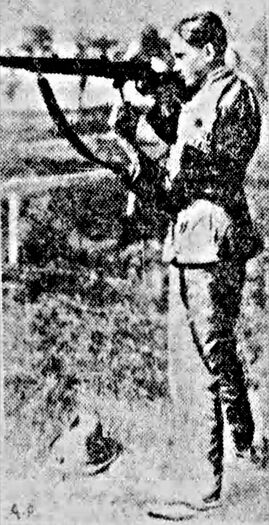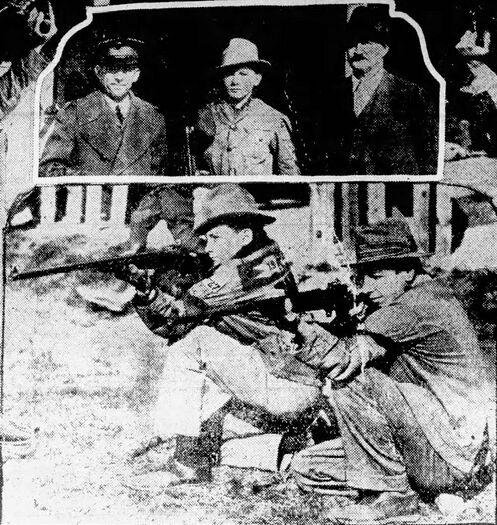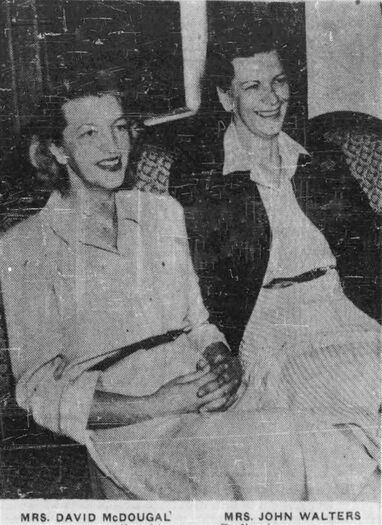DAVID S. MCDOUGAL, LTCOL, USMC
David McDougal '33
Lucky Bag
From the 1933 Lucky Bag:
DAVID STOCKTON McDOUGAL
Washington, D.C.
"Dave" "Mac" "McSquizzle"
Fate made Dave a "Gyrene" Junior and sent him to the far corners of the earth but home to him is Washington. Western High School Cadet Corps gave him his first taste of military discipline. Naturally enough the strains of "Semper Fidelis" strike a resonant chord in his makeup. His lifelong ambition has been to follow in parental footsteps to a long and distinguished service career. With this end in view, concentrated "boning" stands him high enough in the class to get that commission despite Congressional economies and the depression.
His consistently outstanding services for three years on Navy rifle teams have earned him the captaincy of the "indoor" team and a collection of medals that dazzle the eye and quicken the heart. Another of his pet ambitions is to hold down a position on the Marine rifle team.
On Sunday afternoons he could be found either in the pool with the class swimming team or at Carvel tripping the light fantastic. His "snakish" propensities have made him a happy combination of Cassanova and Cyrano de Bergerac.
Good natured and amiable, yet dignified, easy going but efficient; these qualities will continue to make him friends and a welcome messmate on many a far station.
Rifle 4, 3, 2, 1 Captain; Small Bore 4, 3, 2, 1; Captain; Swimming 3, 2, 1; 2 Stripes
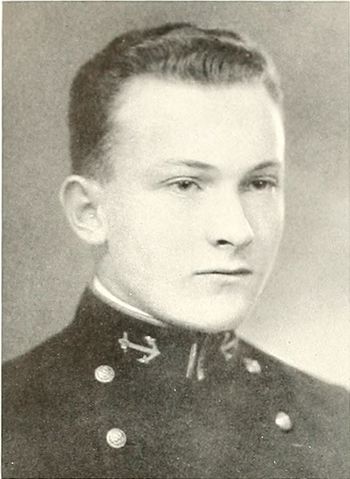
DAVID STOCKTON McDOUGAL
Washington, D.C.
"Dave" "Mac" "McSquizzle"
Fate made Dave a "Gyrene" Junior and sent him to the far corners of the earth but home to him is Washington. Western High School Cadet Corps gave him his first taste of military discipline. Naturally enough the strains of "Semper Fidelis" strike a resonant chord in his makeup. His lifelong ambition has been to follow in parental footsteps to a long and distinguished service career. With this end in view, concentrated "boning" stands him high enough in the class to get that commission despite Congressional economies and the depression.
His consistently outstanding services for three years on Navy rifle teams have earned him the captaincy of the "indoor" team and a collection of medals that dazzle the eye and quicken the heart. Another of his pet ambitions is to hold down a position on the Marine rifle team.
On Sunday afternoons he could be found either in the pool with the class swimming team or at Carvel tripping the light fantastic. His "snakish" propensities have made him a happy combination of Cassanova and Cyrano de Bergerac.
Good natured and amiable, yet dignified, easy going but efficient; these qualities will continue to make him friends and a welcome messmate on many a far station.
Rifle 4, 3, 2, 1 Captain; Small Bore 4, 3, 2, 1; Captain; Swimming 3, 2, 1; 2 Stripes
Loss
David was killed in action on Okinawa on June 14, 1945. Unable to find any details of his loss, except that he had been commanding officer of the 3rd Battalion, 5th Marines, since sometime before December 1943.
Other Information
From the 1953 edition of the book "Double Three Roundup," published by the class of 1933:
Dave was a credit to his class, to the Marine Corps and to the country for which he died. His lifelong ambition was to follow in parental footsteps to a long and distinguished service career. The latter he attained in company with heroic sacrifice of the first objective. He will never be forgotten by his classmates as a good friend, amiable and easy going, yet efficient, or by the Marine Corps which recognized him as one of the most outstanding rifle marksmen in its history. The McDougal Trophy has become a perpetual award for the annual winner of the Marine Corps Rifle Match.
Prior to World War II Dave served in China and Cuba and aboard the ARIZONA and the ASHEVILLE. While attached to the ASHEVILLE he met and married Doreen Parkhill in Shanghai, in 1939. Throughout the pre-war years Dave was very active in Marine Corps and National Rifle Competition. In 1937 at the National Rifle Matches he won the Crowell Trophy competing against a field of almost 2000 and setting a new record, He fired in seven Marine Corps Division Rifle Matches, winning three and taking fourth place in two others to set a Marine Corps Divisional Rifle Match record, He also fired on the Winning Marine Corps Rifle Team in the National Matches in 1940.
During World War II Dave served twenty-two months in the South Pacific in the First Marine Division. He was wounded at Guadalcanal and Cape Gloucester. After serving on the Staff of the 10th Army he rejoined the First Marines. Then during the Okinawa Campaign, Dave was killed on 14 June, 1945. He was awarded two Purple Heart Medals and three Presidential Unit Citations.
Dave is survived by his widow, Doreen, two children, David, Jr., born in 1942, and Eileen Margaret, born in 1945, and his parents Major General and Mrs. Douglas C. McDougal. Doreen was married again, to John A. Botterell, and they and the two children are living in Oakville, Ontario, Canada.
From researcher Kathy Franz:
From The Cincinnati Enquirer, September 2, 1928:
Camp Perry, Ohio, September 1. – The junior rifle corps national small bore matches were brought to a close today with the firing of the national individual championship match, which was won by David McDougal, the seventeen-year-old schoolboy, of Washington, D. C., who had to shoot his way to the top in the last stage at standing position to win over Lawrence Wilkens, 16, of Norwood, Ohio, who had him tied for the first three stages.
McDougal totaled 378 out of a possible 400, while Wilkens was but four points lower with 374. In this event, which was known as the prone-sitting-kneeling-standing match, there were 11 girls and 26 boys competing at ages from 12 to 18 years and the first 13 had scores of 300 or better.
Both McDougal and Wilkens had scores of 99 at prone position, 97 at sitting, 95 at kneeling, and it was at the final stage where the battle waged with interest to the competitors on the line, but McDougal landed 87 and Wilkens could not do better than 83.
From The Sandusky Register, June 24, 1933:
Fremont, June 23 – (Special) – James Bowell … was in a critical condition ... suffering from internal injuries following a traffic accident in U. S. Route 20, east of Fremont.
Boswell was riding with David McDougal, 23, and his brother, Douglas McDougal, 22, of Washington, D. C., when the left rear tire on the car blew out and caused it to turn upside down. David McDougal was hurled clear of the driver’s seat and escaped with a broken rib and cuts and bruises. The brother, Douglas and Bowell were pinned under the car which caught fire.
George Thomsen, deputy county bee inspector, living nearby and a “hitch-hiker” extinguished the flames and carried the victims to safety. Douglas … was severely cut and bruised but both he and his brother will survive. Boswell’s recovery was said to be doubtful.
From the News and Observer, Raleigh, North Carolina, July 13, 1945:
New Bern, July 12. – Lt. Col. David. S. McDougal, 33, Marine officer who resided in New Bern for some time, was killed in action on Okinawa, while serving as operations officer on the staff of Maj. Gen. Pedro del Valle, commander of the First Division and also a former resident of New Bern and Camp Lejeune.
The young officer had recently been transferred from the staff of Lt. Gen. Simon Bolivar Buckner, Tenth Army commander, who also lost his life on Okinawa. He [David] went overseas on his last trip last December. Previously he had served in the Pacific for 22 months and was twice wounded in action, on Guadalcanal and at Cape Gloucester.
A graduate of the Naval Academy in 1933, Colonel McDougal had served with the Marines in all parts of the world. It was while he was at Shanghai, China, that he met Doreen Parkhill, then a British subject, and married her. She survives him at San Diego, with two children, David, Jr., aged three, and Eileen Margaret, three months old, whom he had never seen. Also surviving are his father, Maj. Gen. Douglas C. McDougal, USMC, retired, and his mother [Sabina,] both of whom have spent some time in New Bern; and a brother, Douglas McDougal, Jr., employed by an aircraft company at Fort Worth, Tex.
From the Calgary Herald, Canada, August 30, 1945:
Mrs. Walters and her sister, Mrs. David McDougal, have lived in San Diego, California, for the past two years. They are in Calgary now…
Both young women were born in the Far East … [their] parents remained in Shanghai where her father Arthur J. S. Parkhill was employed by the Canadian Pacific Steamships, and they were interned there.
Mrs. McDougal’s husband Col. David S. McDougal had enlisted with the United States Marine Corps. He was wounded at Guadalcanal and was the first American serviceman to receive blood plasma treatment.
Recovering, he went back into action and was killed a few months ago at Okinawa. The McDougal family has the longest service of any in the American navy. Lt.-Col. McDougal’s grandfather was the first white man to fight the Japanese and he served in the Far East even before Admiral Perry visited Japan.
David’s grandfather, a graduate of the Naval Academy in 1856, was Charles John McDougal (1837-1881.) He was a lighthouse keeper in California. His great-grandfather Rear Admiral David Stockton McDougal (1809-1882) was commander of USS Wyoming (1859), when he fought the Battle of Shimonoseki Straits in Japan on July 16, 1863.
His wife was listed as next of kin. He is buried in California.
Photographs
"Top – Major Harry Smith, team coach; David McDougal, 16, youngest competitor and National Junior Small Bore Champion, and his father, Col. D. C. McDougal, Captain of the American team.
Bottom – David McDougal and Perry Rutherford of Washington, D. C., sixteen-year-old sharpshooters, who are trying to make the Olympic team."From the Port Chester Daily Item on April 23, 1928
Wartime Service
From the Coronado Eagle and Journal on March 2, 1944:
Coronado Marine Officer Wounded Second Time
Marine Lieutenant Colonel David S. McDougal, of Coronado, who was awarded the Order of the Purple Heart for wounds received on Guadalcanal was injured for a second time when his observation party was ambushed by Japanese machine gunners. Lieutenant Colonel McDougal is the son of Major General D. C. McDougal, USMC, (Ret,), of 508 Glorietta Blvd., and was wounded in the left arm when he and his party entered a supposedly evacuated Japanese area in New Britain. Advance scouts had marked the area as safe a half hour before, but the enemy had returned in time to set up a machine gun position, Lt. Col. McDougal said. The officer is home for the first time in several years and is recuperating in a local service hospital.
Other documentation indicates it was a gunshot wound to his right shoulder.
Guadalcanal
David, a Major, was commanding officer of the 2nd Battalion, 5th Marines for the first seven days of October 1942; he was wounded on October 7. It appears he himself had taken over for an officer who had been killed or wounded. The battalion had seven commanding officers between September 10th and October 12th, 1942.
New Britain Campaign
David, commanding the 3rd Battalion, 5th Marines, was wounded in action on January 7, 1944. His executive officer was wounded later that day, and for several days command of the battalion was assumed by Lt. Col. Lewis "Chesty" Puller, who was simultaneously commanding the 3rd Battalion, 7th Marines.
The "Register of Commissioned and Warrant Officers of the United States Navy and Marine Corps" was published annually from 1815 through at least the 1970s; it provided rank, command or station, and occasionally billet until the beginning of World War II when command/station was no longer included. Scanned copies were reviewed and data entered from the mid-1840s through 1922, when more-frequent Navy Directories were available.
The Navy Directory was a publication that provided information on the command, billet, and rank of every active and retired naval officer. Single editions have been found online from January 1915 and March 1918, and then from three to six editions per year from 1923 through 1940; the final edition is from April 1941.
The entries in both series of documents are sometimes cryptic and confusing. They are often inconsistent, even within an edition, with the name of commands; this is especially true for aviation squadrons in the 1920s and early 1930s.
Alumni listed at the same command may or may not have had significant interactions; they could have shared a stateroom or workspace, stood many hours of watch together, or, especially at the larger commands, they might not have known each other at all. The information provides the opportunity to draw connections that are otherwise invisible, though, and gives a fuller view of the professional experiences of these alumni in Memorial Hall.
July 1933
October 1933
April 1934
July 1934
October 1934
January 1935
April 1935
October 1935
January 1936
April 1936
July 1936
January 1937
April 1937
September 1937
January 1938
July 1938
January 1939
October 1939
June 1940
November 1940
April 1941
Memorial Trophy
From USMC Shooting Trophies:
The Marine Corps Rifle Match became a part of the annual competition in 1909. In its early years competitors to the Marine Corps Rifle Match came from team members and marksmen who had successfully competed in the Division Rifle Match at Winthrop, Maryland. The other Division medal winners were not ordered to the Marine Corps Rifle Match. In some years the event was fired after the conclusion of the National Matches. In 1919 the present system of Division medal-winners competing in the Marine Corps Rifle Match was adopted.
The Trophy is named in honor of Lieutenant Colonel David S. McDougal. It was the first awarded in 1947 when Major General Douglas C. McDougal, his father, presented the Trophy to the Marine Corps in behalf of the family and friends of the late Colonel McDougal.
David McDougal at 16 years old, placed third among more than 1,000 competitors in the President's Match. After graduation from the Naval Academy in 1933, he was commissioned in the Marine Corps. Two years later he had Distinguished with both rifle and pistol. Fired with 1935, 1936, 1937 and 1940 Marine Corps teams. In World War II, after fighting throughout the Pacific, McDougal was killed in action on Okinawa in 1945.
The competitor attaining the highest aggregate score in the Marine Corps Individual Rifle Match will be awarded a replica trophy plaque of the David S. McDougal Memorial Trophy and a special gold badge. The name and score of the winner will be engraved on the trophy which, under the conditions of the award, is permanently displayed at WTBn, Quantico.
The Marine Corps Rifle Match winner was awarded a medal, suitable for wearing on the uniform since 1952.

The "category" links below lead to lists of related Honorees; use them to explore further the service and sacrifice of alumni in Memorial Hall.
